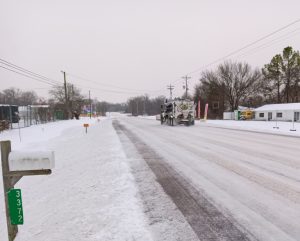STAFF REPORT

On U.S. Highway 41A, a Tennessee Department of Transportation snow plow is seen heading south-bound through Unionville. (Submitted photo)
According to Highway Superintendent Mark Clanton, Unionville-Deason Road and other roads in northern Bedford County were “extremely dangerous” on the evening of Thursday, Jan. 18, while Horse Mountain Road, from the 437 Bypass to the city limits, was blocked by a tractor-trailer that slid off the road.
Although Clanton and his crews have cleared 25 rural roads, last week’s latest round of precipitation froze as a sheet of ice on the pavement, making it a hazard to motorists.
Last week, government offices remained closed throughout the entire week while meetings and court dates were rescheduled to this week or to February. Many local businesses remained closed or had altered hours. Bedford County School remained closed through the entire week as well as on Monday using five of their eight inclement weather days.
During that time, Clanton advised drivers to stay off rural side roads, which he said were “very dangerous” due to melting and refreezing. Dangerous conditions continued until Monday, when temperatures rose into the 40s.
Bedford County Highway Department re-salted some of the worst roads in the county last Friday, but temperatures remained so low that salt will not be effective and the roads will refreeze.
Historical snowfall
Despite the sub-zero temperatures and nearly half-foot of snow, this weather pattern hasn’t been the worst to come to Bedford County.
In Bedford County, Shelbyville was reported to have at least 6.5 inches, while county municipalities like Wartrace saw at least 6 inches on MLK Day.
According to data from the National Oceanic and Atmospheric Administration (NOAA), Bedford County set its snowfall record almost 130 years ago, on Feb. 25, 1894, when the county received 15 inches of snow over 24 hours.
According to Nashville’s National Weather Service, Music City accumulated 7.6 inches of snow, over 6 inches of which occurred on MLK Day, Jan. 15.
Historically, using data from the National Centers for Environmental Information, some of the biggest 1-day snowfalls in Tennessee were in March.
– Shelby County: 18 inches on March 17, 1892
– Gibson County: 18 inches on Dec. 8, 1917
– Fentress County: 18 inches on February 4, 1998
– Cumberland County: 18 inches on March 13, 1993
– Hamilton County: 18.5 inches on March 13, 1993
– Washington County: 19.8 inches on March 18, 1936
– Johnson County: 20 inches on March 14, 1993
– Carter County: 20.8 inches on March 18, 1936
– Sullivan County: 24 inches on March 18, 1936
– Sevier County: 30 inches on March 14, 1993
There were also a reported 14 deaths across Tennessee related to the snow.
So, for any future snowy days, here are a few safety and energy tips to use to keep you and your family safe.
When you are outside, frostbite and hypothermia are possible. To protect yourself, you can wear layers of loose-fitting, lightweight, warm clothing. Wear a hat, and try to stay dry and out of the wind. Cover your mouth to protect your lungs from extreme cold. Mittens that are snug at the wrist are better than gloves.
Ice safety
To keep pipes from freezing on an outside wall let hot- and cold-water trickle or drip at night from a faucet. You can also open cabinet doors to allow more heat to get to un-insulated pipes under a sink or near an outer wall.
If your pipes do freeze, make sure you and your family know how to shut off the water in case pipes burst. Never try to thaw a pipe with an open flame or torch. Instead, use a hair dryer, and always be careful of the potential for electric shock in and around standing water.
Heaters
For wood-burning stoves, fireplaces and heaters, always keep a screen around an open flame. Never use gasoline to start your fireplace, and never burn charcoal indoors. Do not close the damper when ashes are hot.
Use only safe sources of alternative heat such as a fireplace, small well-vented wood or coal stove or portable space heaters. Always follow the manufacturer’s instructions.
Carbon monoxide poisoning is a silent, deadly killer claiming about 1,000 lives each year in the United States. For prevention, install a carbon monoxide detector. Never run generators indoors or use a gas oven to heat your home.
If using a kerosene heater, open a window slightly and follow the manufacturer’s instructions.
If your heat goes out, you can keep warm indoors by closing off rooms you do not need, dressing in layers of lightweight clothing, and wearing a cap.
Vehicle Preparation
Check your battery and fluids (coolant, wiper fluid, oil, etc.) when temperatures are below freezing. 4. Have jumper cables on hand. Also, check tire pressure and pack a blanket in your car in case of an emergency.
Shelbyville Power, Water, and Sewerage gave five safety tips to keep your home running efficiently:
- Open the curtains of south-facing windows during the day to allow sunlight to naturally heat the home. Close them at night to reduce the chill from the cold windows.
- You can place blankets or towels, rolled up, against the bottom of doors to keep cold from seeping in.
- It is recommended that you set your thermostat to 68 degrees when you are asleep or away from the house. If you plan to be away, have someone check your house daily to make sure the heat is still on to prevent freezing, or drain and shut off the water system (except for indoor sprinkler systems).
- Instead of turning up the heat, wear a blanket or sweater if you’re feeling chilly.
- Many electronics and appliances draw energy even when they are set to “off.” Common “energy vampires” include desktop computers, printers, TVs, microwaves, and video game consoles. You can save energy by unplugging these devices when they aren’t being used.
Press releases from the Bedford County Government contributed to this article.



![For-Tips-and-Ideas-Phone-300x250-Bedford-County-Post[1]](https://www.bedfordcountypost.com/wp-content/uploads/2023/09/For-Tips-and-Ideas-Phone-300x250-Bedford-County-Post1-300x250.jpg)
![Subscribe-Now-300x250-Bedford-County-Post[1]](https://www.bedfordcountypost.com/wp-content/uploads/2023/09/Subscribe-Now-300x250-Bedford-County-Post1-300x250.jpg)

